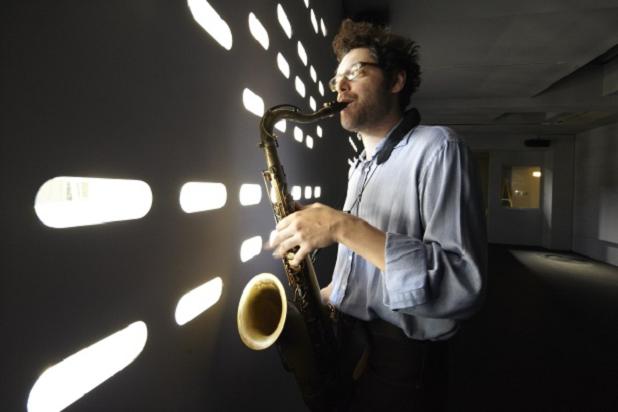Review: Anri Sala (Serpentine Gallery) Arts & Culture
Arts & Culture, New in Ceasefire - Posted on Thursday, November 10, 2011 10:57 - 2 Comments
By Peter Shenai
(Photo © Sylvain Deleu 2011)
Under a small dome in the Serpentine Gallery entrance, a snare drum is playing itself. Two drumsticks balance on the edge of the snare, softly pattering against its skin. The effect is natural, not mechanized. Its volume swells and subsides dramatically, generating a sense of performance despite the absence of a performer.
Under a large dome at the back of the gallery, a film of a man playing the drums is projected at a cinematic scale. Initially, the footage focuses on the performer, but subsequent shots locate the performance under a colossal dome. The digital sound produced by the speakers echoes around the Gallery’s dome, conflating digital space and real space, heightening the sense of performance.
These two works are linked by more than shared references and theatricality: one is producing the other. The sound produced by the film is fed, via a live microphone, directly into the snare drum, causing the instrument to vibrate and produce its own sound.
Anri Sala’s current exhibition masterfully relocates sound and musical performance between different spaces. Video, installation, live performance and objects comprise a web of echoing artworks, whose ranging subject matter becomes all the more poignant in the context of shared space.
Two films play simultaneously in different rooms. In Le Clash(2010), performers outside a derelict concert hall in Bordeaux play new renditions of the song Should I Stay or Should I Go through a barrel organ and a music box. In Untitled (2011), figures among the ruins of the Tlateloco area of Mexico City insert fragments of a musical score into a barrel organ, creating a disjointed echo of the same song. A cultural fragment of the punk era is relocated through time and geography, re-kindling the question first asked in the song’s title.
In one sense, this pair of films is a portrait of two desolate geographies and their unstable social climates. In another sense, they portray their maker: Sala comes from Albania, a country affected by high levels of migration. Perhaps this artist, like so many other ‘international’ contemporary artists, wishes to express his mixed feelings towards a nomadic lifestyle, and a regret for the diminishing population of his former home.
Amongst such complexity of echoes and references, it is easy to imagine Sala’s exhibition as a mighty din, whose parts are only discernible through reading, not listening. Exactly the opposite is true. The entire event is superbly choreographed: at various points, saxophonists lead audiences, pied piper-style, through the space, improvising alongside videos, or stopping to allow sound to echo in the Serpentine’s colossal dome. Most of the time, only a couple of videos play, inviting viewers out of a cinematic passivity and into action in search of the source of noises.
The Serpentine Gallery enjoys a rare position as a major institution of contemporary art situated in a natural environment. To get to an exhibition, one has to travel through a city, across a park, and into a building. The ‘Russian doll’ aspect to the journey has often extended into the Serpentine’s curatorial ethos: just recently, Peter Zumthor described his design for the annual Serpentine pavilion as ‘a garden within a garden’. Anri Sala’s exhibition continues this curatorial experiment, playing with the dynamic social possibilities of the site.
The show manipulates the flow of its audience: performance and videos converse from different spaces, causing attentive audiences to behave like tides, and making the echoes themselves visible. Small openings representing the perforated score of a barrel organ have been carved out of the gallery walls, allowing sound and light to travel freely between the park and the exhibition. This simple intervention produces new social flows; in one instance I watched children in the park flock to the gallery wall as a saxophonist played his instrument through the openings.
The Serpentine Gallery caters for a wide demographic. All too often, popular institutions choose shocking or controversial exhibition content, in order to draw attention away from mundane and unchallenging exhibition structures. This show is the antidote to such an attitude. Sala uses sound to prompt the flows of audiences. These flows generate a dynamic and charged atmosphere, in which art theorists and art laymen become equally excited. The content of the films is light and humorous, but they reflect very real social issues facing us all – migration, cultural amnesia, and digitalisation, to name a few.
Anri Sala’s exhibition is more than one outstanding achievement: it is a marriage of spectacle and art, an ongoing performance, and a poetic visualisation of echoes.
Exhibition runs until the 20 Novemeber at The Serpentine Gallery, Hyde Park, London. ( Admission Free).
2 Comments
[…] 2011 at Serpentine Gallery, London Soundfair GbR. Ari Benjamin Meyers, Clara Meister, Thomas Mayer, Alexandrinenstr. 2/3, […]



At last some rtianoaltiy in our little debate.